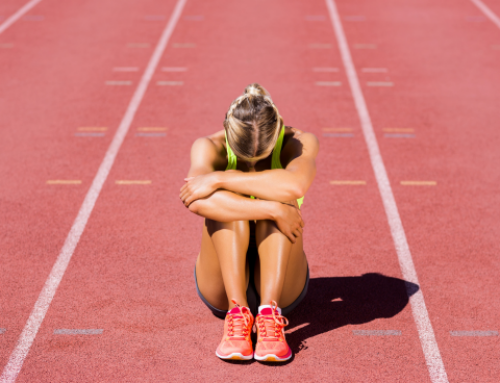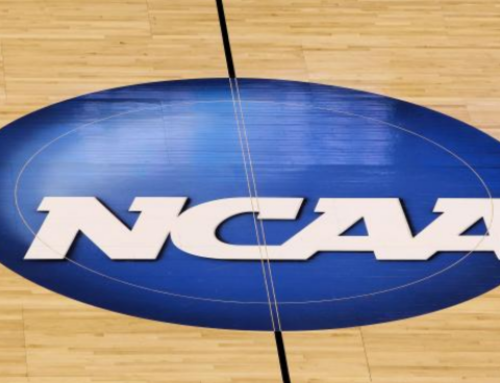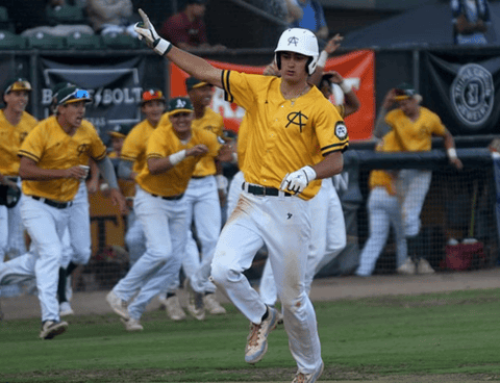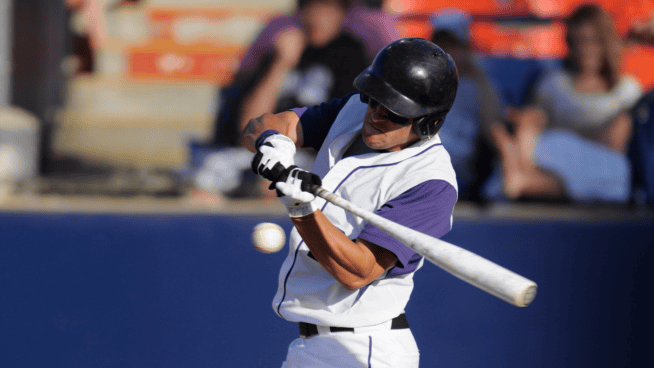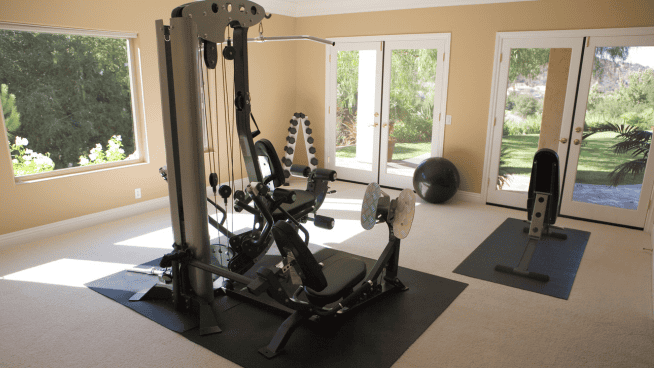In this article, I want to show you some of the most effective bodyweight hockey training drills and workouts that you can do to start improving your hockey-specific speed, conditioning, and deliver power.
You might be thinking that COVID-19 created an unpredictable training environment for the young hockey kids out there, but one thing I can tell you right now is that a lack of exercise equipment or training partners will not stop you from reaching your potential in this sport.
Don’t believe me? Let’s get into the science behind why bodyweight-only training is my preferred method for optimizing youth hockey player’s performance out on the ice.
Bodyweight Hockey Training for Kids
Bodyweight exercises are strength training exercises that do not require the addition of any machines, barbells, or dumbbells. The hockey player’s weight will provide resistance to all movements within this type of program design, which I heavily prefer for kids.
The more traditional bodyweight exercises include push-ups and squats. The challenge most parents and coaches run into is designing a hockey training program that has an effective way of increasing and decreasing the difficulty of an exercise to meet their needs and abilities.
This isn’t an obstacle to creating super effective hockey workouts that kids can do at home during quarantine (or any other time of the year, for that matter).
Take a Push-up, for example. If you want to make it less complicated, you have plenty of options. You can change your hand position, establish pauses throughout the set, put your knees down, increase your support base, or reduce the range of motion.
To make the Push-up more difficult, you have just as many options.
- Change your hand position
- Force isometric pauses
- Perform failure sets
- Pre-exhaust the muscles before doing push-ups
- Slow down the tempo
- Increase the range of motion
- Elevate your feet to place a greater load of your total body weight on the upper body musculature active in the push-up
These variations won’t only increase the exercise’s difficulty, but they can also increase the range of motion and recruit more muscle fibers per rep. In a general sense, an increase in reps will improve your hockey-specific endurance.
Method for Training Youth Hockey Players
Bodyweight training is no joke. I have hundreds of hockey players who have gone through my bodyweight-only programming with massive success.
Outside of the sport of hockey, to assess the effectiveness of bodyweight-only training, you don’t need to look any further than checking out the strength, power output, and extreme athletic capability of elite gymnasts.
Bodyweight training checks all of the boxes for dryland hockey performance development and can be a tremendous tool in your arsenal as a coach or parent to better train your youth hockey players.
Advantages Of Bodyweight Training Over Weight Training
Versatility: Bodyweight training is suitable for both advanced hockey trainees and brand-new beginners because each exercise has so many variations to make it either harder or easier on the athlete’s current ability level.
Convenience: All you need is your body, so your youth hockey player can get a great workout anywhere, anytime. Not to mention, he/she won’t have to go to the gym at all and risk being intimidated by some bodybuilder throwing clanging weight around and shouting beside him/her.
Cost: Bodyweight training costs you next to nothing compared to other training programs that demand lots of costly machines, plates, cardio equipment, heart rate monitors, and specialty bars.
Efficient: Even people with the busiest of schedules can sneak in a bodyweight workout. You can do these anywhere, anytime, and they will all take a half-hour or less. Additionally, the minimum equipment needed allows for the quickest transitions between exercises (no more waiting for machines at the gym!) and shorter rest periods.
Adaptability: Bodyweight training does not need to be just a warm-up or cardio session. Bodyweight training exercises can be placed in a program and performed to provide hockey-specific strength and muscle gain across a fully periodized hockey training program.
Compound Movements: Almost all bodyweight exercises involve multiple joints and several different muscle groups firing simultaneously. When alternated back and forth in a high-intensity fashion, these exercises have been demonstrated to increase circulating concentrations of health-promoting hormones, which are largely beneficial towards sports performance, health, and body composition enhancement.
Core strength: The core contains approximately 29 different main muscles, and bodyweight training alone can engage all of these by hitting them directly or using them in a stabilizing challenge. This won’t only give you some additional armor to prevent injury out on the ice, but it can directly translate to your speed, agility, conditioning, balance, and shot power.
Nervous System Adaptability: Through bodyweight-only training, you expose your muscle system and nervous system to hundreds of different coordination patterns, and you force the body to execute these patterns under varying degrees of stress and fatigue.
All-Around Increased Hockey Performance: Bodyweight training forces you to build a functional, athletic physique because you are forced to be maximally coordinated throughout every movement. You will build lean, athletic, and symmetrical muscle that will function with a high level of mobility that you will see a direct transfer over to hockey performance.
Using Body Weight Training Properly for Hockey Players
Bodyweight training has been an incredibly useful tool for conditioning, agility, coordination, balance, power development, increasing strength, burning body fat, building muscle tissue, and pushing human performance limits for centuries.
Too many parents think it’s “better” to use weights early, but I disagree entirely. Weight training can wait for when the body needs it more (after the onset of puberty). Until then, bodyweight-only practice isn’t only safer — it’s better for producing hockey-specific results.
Bodyweight training is just like any other form of exercise. Over time, you will continue to make linear progress so long as you continue to apply an overload stimulus to every workout.
Below, I’m going to provide you one hockey-specific speed, conditioning, and shot power workout so you can start turbo-charging your at-home training in the best way possible to become a better hockey player. Let’s get into it!
Body Weight Hockey Speed Workout
- A1: Split Squat Jumps – 3 x 3/side jump [0 secs rest]
- A2: Prisoner Reverse Lunges – 3 x 5/side [0 secs rest]
- A3: Flutter Kicks – 3 x 10/side [0 secs rest]
- A4: Broad Jumps – 3 x 6 [0 secs rest]
- A5: Prisoner Forward Lunges – 3 x 5/side [0 secs rest]
- A6: Plank w/ Elbow to Knee Touches – 3 x 10/side [90 secs rest]
*Complete all six exercises back-to-back with minimal rest in between, once completed rest for 90 seconds and repeat for three total rounds.
Body Weight Hockey Shot Power Workout
- A1: Yoga push-ups x 10
- A2: Y-T-W x 10/letter
- A3: X-ups x 10/side
*Repeat for 3 rounds, rest 90 secs
- B1: Pike push-ups x 10
- B2: Reverse snow angels x 10
- B3: Renegade row x 10/side
*Repeat for 3 rounds, rest 90 secs
- C: Push-up bird dog x 10/side
Perform for only one set as a finisher
Body Weight Hockey Conditioning Workout
- A1: Split squats x 6/leg
- A2: 3-Way push ups x 12
- A3: Reverse crunches x 10
- A4: Bodyweight pause squats x 10
- A5: Downward dog Push-ups x 10
- A6: Side V’s x 6/side
- A7: Military burpee’s x 10
- A8: Broad jump x 3
*Repeat 3-5x with 2mins rest in between.
Final Thoughts
The unfortunate regulations of COVID-19 can be avoided with an intelligent approach to at-home training. This period in youth athletes’ life that is the most critical window for creating short and long term hockey performance potential.
Youth hockey program design and making it fun are equally essential and continuously feed into each other as your performance progresses. The marriage between these two concepts will give you the objective performance results to validate the approach when you see their performance on a different level in the next season — with or without training equipment.
Ignoring the principles of program design that make up the foundation of your dryland training is a one-way ticket to having a minimally effective quarantine.
You can’t expect your kid to get better by “winging” their program design or waiting for everything to go back to normal again.
Many hockey athletes out there don’t improve their performance very much from year-to-year. The #1 reason this happens is that they routinely overlook the complexity behind simple program design. Or they are training their kids like mini-adults (which is a huge mistake!).
The hardest worker in the room does NOT always get the best results.
Instead, it’s the hardest worker who can put their efforts into hockey performance enhancement is going to win in the end. Why? Because no matter how hard you work on a sub-optimal program, you’re still going to receive sub-optimal results.
Youth hockey players need to be on a youth-specific hockey training plan. A well-designed youth hockey training program does not demand you need access to an entire gym of equipment.
Don’t let COVID-19 hold you back from your hockey dreams, do these workouts, and dominate on the ice!
Read More
RECOMMENDED FOR YOU
In this article, I want to show you some of the most effective bodyweight hockey training drills and workouts that you can do to start improving your hockey-specific speed, conditioning, and deliver power.
You might be thinking that COVID-19 created an unpredictable training environment for the young hockey kids out there, but one thing I can tell you right now is that a lack of exercise equipment or training partners will not stop you from reaching your potential in this sport.
Don’t believe me? Let’s get into the science behind why bodyweight-only training is my preferred method for optimizing youth hockey player’s performance out on the ice.
Bodyweight Hockey Training for Kids
Bodyweight exercises are strength training exercises that do not require the addition of any machines, barbells, or dumbbells. The hockey player’s weight will provide resistance to all movements within this type of program design, which I heavily prefer for kids.
The more traditional bodyweight exercises include push-ups and squats. The challenge most parents and coaches run into is designing a hockey training program that has an effective way of increasing and decreasing the difficulty of an exercise to meet their needs and abilities.
This isn’t an obstacle to creating super effective hockey workouts that kids can do at home during quarantine (or any other time of the year, for that matter).
Take a Push-up, for example. If you want to make it less complicated, you have plenty of options. You can change your hand position, establish pauses throughout the set, put your knees down, increase your support base, or reduce the range of motion.
To make the Push-up more difficult, you have just as many options.
- Change your hand position
- Force isometric pauses
- Perform failure sets
- Pre-exhaust the muscles before doing push-ups
- Slow down the tempo
- Increase the range of motion
- Elevate your feet to place a greater load of your total body weight on the upper body musculature active in the push-up
These variations won’t only increase the exercise’s difficulty, but they can also increase the range of motion and recruit more muscle fibers per rep. In a general sense, an increase in reps will improve your hockey-specific endurance.
Method for Training Youth Hockey Players
Bodyweight training is no joke. I have hundreds of hockey players who have gone through my bodyweight-only programming with massive success.
Outside of the sport of hockey, to assess the effectiveness of bodyweight-only training, you don’t need to look any further than checking out the strength, power output, and extreme athletic capability of elite gymnasts.
Bodyweight training checks all of the boxes for dryland hockey performance development and can be a tremendous tool in your arsenal as a coach or parent to better train your youth hockey players.
Advantages Of Bodyweight Training Over Weight Training
Versatility: Bodyweight training is suitable for both advanced hockey trainees and brand-new beginners because each exercise has so many variations to make it either harder or easier on the athlete’s current ability level.
Convenience: All you need is your body, so your youth hockey player can get a great workout anywhere, anytime. Not to mention, he/she won’t have to go to the gym at all and risk being intimidated by some bodybuilder throwing clanging weight around and shouting beside him/her.
Cost: Bodyweight training costs you next to nothing compared to other training programs that demand lots of costly machines, plates, cardio equipment, heart rate monitors, and specialty bars.
Efficient: Even people with the busiest of schedules can sneak in a bodyweight workout. You can do these anywhere, anytime, and they will all take a half-hour or less. Additionally, the minimum equipment needed allows for the quickest transitions between exercises (no more waiting for machines at the gym!) and shorter rest periods.
Adaptability: Bodyweight training does not need to be just a warm-up or cardio session. Bodyweight training exercises can be placed in a program and performed to provide hockey-specific strength and muscle gain across a fully periodized hockey training program.
Compound Movements: Almost all bodyweight exercises involve multiple joints and several different muscle groups firing simultaneously. When alternated back and forth in a high-intensity fashion, these exercises have been demonstrated to increase circulating concentrations of health-promoting hormones, which are largely beneficial towards sports performance, health, and body composition enhancement.
Core strength: The core contains approximately 29 different main muscles, and bodyweight training alone can engage all of these by hitting them directly or using them in a stabilizing challenge. This won’t only give you some additional armor to prevent injury out on the ice, but it can directly translate to your speed, agility, conditioning, balance, and shot power.
Nervous System Adaptability: Through bodyweight-only training, you expose your muscle system and nervous system to hundreds of different coordination patterns, and you force the body to execute these patterns under varying degrees of stress and fatigue.
All-Around Increased Hockey Performance: Bodyweight training forces you to build a functional, athletic physique because you are forced to be maximally coordinated throughout every movement. You will build lean, athletic, and symmetrical muscle that will function with a high level of mobility that you will see a direct transfer over to hockey performance.
Using Body Weight Training Properly for Hockey Players
Bodyweight training has been an incredibly useful tool for conditioning, agility, coordination, balance, power development, increasing strength, burning body fat, building muscle tissue, and pushing human performance limits for centuries.
Too many parents think it’s “better” to use weights early, but I disagree entirely. Weight training can wait for when the body needs it more (after the onset of puberty). Until then, bodyweight-only practice isn’t only safer — it’s better for producing hockey-specific results.
Bodyweight training is just like any other form of exercise. Over time, you will continue to make linear progress so long as you continue to apply an overload stimulus to every workout.
Below, I’m going to provide you one hockey-specific speed, conditioning, and shot power workout so you can start turbo-charging your at-home training in the best way possible to become a better hockey player. Let’s get into it!
Body Weight Hockey Speed Workout
- A1: Split Squat Jumps – 3 x 3/side jump [0 secs rest]
- A2: Prisoner Reverse Lunges – 3 x 5/side [0 secs rest]
- A3: Flutter Kicks – 3 x 10/side [0 secs rest]
- A4: Broad Jumps – 3 x 6 [0 secs rest]
- A5: Prisoner Forward Lunges – 3 x 5/side [0 secs rest]
- A6: Plank w/ Elbow to Knee Touches – 3 x 10/side [90 secs rest]
*Complete all six exercises back-to-back with minimal rest in between, once completed rest for 90 seconds and repeat for three total rounds.
Body Weight Hockey Shot Power Workout
- A1: Yoga push-ups x 10
- A2: Y-T-W x 10/letter
- A3: X-ups x 10/side
*Repeat for 3 rounds, rest 90 secs
- B1: Pike push-ups x 10
- B2: Reverse snow angels x 10
- B3: Renegade row x 10/side
*Repeat for 3 rounds, rest 90 secs
- C: Push-up bird dog x 10/side
Perform for only one set as a finisher
Body Weight Hockey Conditioning Workout
- A1: Split squats x 6/leg
- A2: 3-Way push ups x 12
- A3: Reverse crunches x 10
- A4: Bodyweight pause squats x 10
- A5: Downward dog Push-ups x 10
- A6: Side V’s x 6/side
- A7: Military burpee’s x 10
- A8: Broad jump x 3
*Repeat 3-5x with 2mins rest in between.
Final Thoughts
The unfortunate regulations of COVID-19 can be avoided with an intelligent approach to at-home training. This period in youth athletes’ life that is the most critical window for creating short and long term hockey performance potential.
Youth hockey program design and making it fun are equally essential and continuously feed into each other as your performance progresses. The marriage between these two concepts will give you the objective performance results to validate the approach when you see their performance on a different level in the next season — with or without training equipment.
Ignoring the principles of program design that make up the foundation of your dryland training is a one-way ticket to having a minimally effective quarantine.
You can’t expect your kid to get better by “winging” their program design or waiting for everything to go back to normal again.
Many hockey athletes out there don’t improve their performance very much from year-to-year. The #1 reason this happens is that they routinely overlook the complexity behind simple program design. Or they are training their kids like mini-adults (which is a huge mistake!).
The hardest worker in the room does NOT always get the best results.
Instead, it’s the hardest worker who can put their efforts into hockey performance enhancement is going to win in the end. Why? Because no matter how hard you work on a sub-optimal program, you’re still going to receive sub-optimal results.
Youth hockey players need to be on a youth-specific hockey training plan. A well-designed youth hockey training program does not demand you need access to an entire gym of equipment.
Don’t let COVID-19 hold you back from your hockey dreams, do these workouts, and dominate on the ice!
Read More


